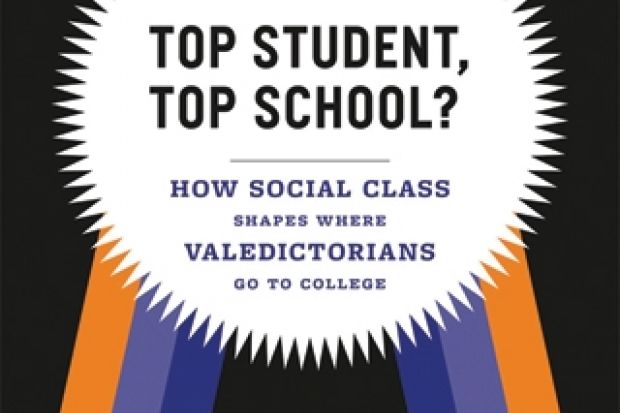After reading this book, I was reminded of an important point. Had it not been for the fact that my education, in which I was carefully taught from undergraduate to doctoral level at top institutions, came at absolutely no cost to me or my family, I might not have been reviewing it at all. Its author explains why.
Alexandra Walton Radford recounts an often painful story of the admissions processes for US higher education institutions. She focuses on valedictorians, the pupils who are chosen to deliver an end-of-year address in recognition of having graduated at the top of their high-school class. As she points out, the life choices of these bright young people are often directly affected by their social and economic backgrounds, with those from poor families frequently unable to benefit from the very best of what the US university system has to offer. While the sector might nod in the direction of equality and diversity (as it must, for that is the modern way), the harsh reality is anything but equal. Through copious use of charts and tables (which are easy to read, I must hasten to add), Radford paints a picture of a dysfunctional system in which the inclusive rhetoric of US university admissions is strongly at odds with the way the process fails a significant proportion of its brightest students. This is despite equality of educational opportunity having been identified as a key issue of concern as far back as the Coleman report, Equality of Educational Opportunity, in 1966.
US systems are replicating advantage and disadvantage over generations. Those who have cracked the code of financial and career success are able to pass on this knowledge to their children, while indirectly keeping others away from such knowledge, in order to maintain its value
Reasons given for this failure are many and various. Most alarming is the misguided belief among many of these students that the “sticker price” of attending a top university is what they would actually pay. Owing to ignorance about student funding packages, families are steered towards less prestigious institutions and are, with a cruel irony, often required to pay more for the privilege than had their children attended Ivy League institutions. (Yes, dear reader, more. Despite all the knock-on effects that might be expected in terms of their children’s reduced future prospects and so on.) Other reasons given are students being unused to being away from home, being disinclined to pay multiple application or testing fees, or simply being surrounded by people with no clue about the best way to gain entrance to top institutions. For some students, it is clearly a maze.
Before we engage in too much outrage, however, we must ask ourselves whether what we are seeing is a better distribution of top students across a range of institutions than in the UK, where they tend to cluster in a relatively limited number of universities. Could it be that our own class obsession colours our view of markets in higher education? (I am not sure I believe that argument, but there may be something in it.)
The key point Radford makes, however, is that US systems are replicating advantage and disadvantage over generations. Those who have cracked the code of financial and career success are able to pass on this knowledge to their children, while indirectly keeping others away from such knowledge, in order to maintain its value. Here, Radford has carefully documented an ongoing polarisation of privilege while putting forward pragmatic suggestions for improvement.
Lecturers in education will find this a useful and accessible companion book to Rebekah Nathan’s 2006 study My Freshman Year: What a Professor Learned By Becoming a Student, as it fleshes out Nathan’s ethnographic findings. For more advanced students, it is perhaps worth pairing with Education: Culture, Economy and Society (A.H. Halsey et al., 1997).
But its greatest strength is the way Radford has managed to lay bare, very concisely and in only eight short chapters, the way the US collectively fritters away its top student talent without so much as a shrug.
Top Student, Top School? How Social Class Shapes Where Valedictorians Go To College
By Alexandria Walton Radford
University of Chicago Press. 296pp, £59.50 and £19.50
ISBN 9780226040950, 41001 and 9780226041148 (e-book)
Published 4 June 2013
Register to continue
Why register?
- Registration is free and only takes a moment
- Once registered, you can read 3 articles a month
- Sign up for our newsletter
Subscribe
Or subscribe for unlimited access to:
- Unlimited access to news, views, insights & reviews
- Digital editions
- Digital access to THE’s university and college rankings analysis
Already registered or a current subscriber? Login




